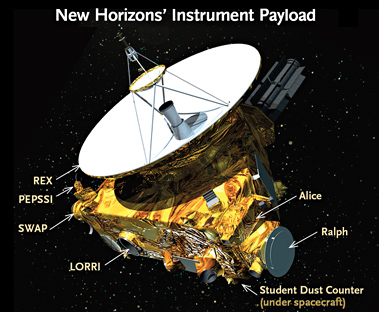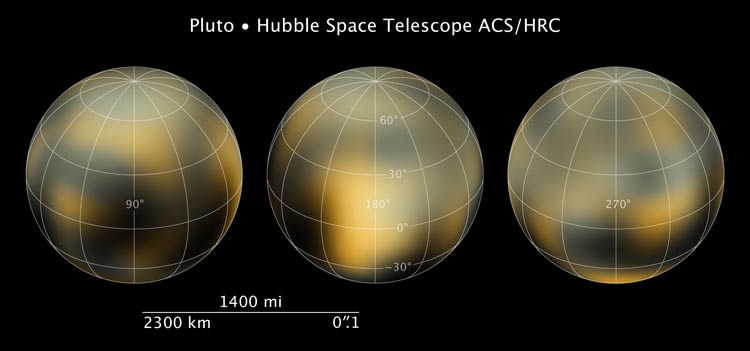In his second "insider blog" about the New Horizons mission, principle investigator Alan Stern offers a look at what we might find at Pluto.

NASA / JHU-APL / Southwest Research Inst.
It sounds like science fiction, but it's not: NASA's New Horizons spacecraft is on final approach to the Pluto system! After 112 months in flight, the fastest spacecraft ever launched is now barely 60 days from its destination. It will be closest to Pluto on July 14th at 11:49:58 Universal Time.
So what might we find when the spacecraft finally gets there?
Before answering that, I have to admit that this kind of speculation is both dangerous and oftentimes wrong. Remember: New Horizons is a "first-reconnaissance" mission to a wholly new kind of planet. As history has shown, that just increases the opportunity for me to be wrong!
After all, consider: No one expected to find large numbers of dry riverbeds and fluvial features on Mars when it was first explored by NASA's Mariner spacecraft. Few expected either volcanoes or internal oceans on the satellites of Jupiter, or geysers on Triton, or a planet stripped of its mantle at Mercury. The hallmark of first-reconnaissance flybys has been their tendency to surprise and make advance predictions look quaint — usually because we underestimate the richness and variety of expressions that nature presents in our solar system. I hope, and I bet, that the same will be true when the Pluto system is revealed in July.
And revealed it will be. New Horizons is a highly capable, 21st-century spacecraft, and it carries an amazing battery of advanced scientific instruments to conduct the first close-up reconnaissance of the planet and its five already known moons. This payload includes:

NASA / JHU-APL / Southwest Research Inst.
- Ralph: a color and panchromatic imager and infrared spectral composition mapper to map the surfaces, surface compositions, and temperatures across Pluto and its satellites.
- LORRI: a long-focal-length visible panchromatic imager to make both distant and hi-res maps (including stereo topography) of Pluto and all its satellites.
- Alice: an ultraviolet imaging spectrometer to determine the composition and density of Pluto's atmosphere and to search for an atmosphere around Charon.
- REX: two radio-science payloads to probe the vertical pressure and temperature profile of Pluto's atmosphere and to make thermal measurements of both Pluto and Charon.
- SWAP and PEPSSI: charged-particle detectors to sample material from Pluto's escaping atmosphere and to detect any magnetic fields associated with Pluto or Charon.
- Venetia Burney Student Dust Counter: to assay the dust density in the Pluto system; built by students at the University of Colorado.
Having worked toward getting to the Pluto system explored since 1989, I can tell you that I often think of Pluto and its moons as holiday presents under a tree I've been waiting to open and reveal for a very long time — but, this year, the holidays come in July!
Pluto: Frigid and Mysterious

NASA / ESA / M. Buie
Since its discovery 85 years ago, we've learned surprisingly little about Pluto (and, in time, its moon) from afar. About all we know is as follows:
Pluto has very distinct surface markings, including apparent polar caps, and it has an atmosphere (mostly nitrogen). We know that Pluto's interior is primarily made of rock — about 70% by mass. Also, Pluto-Charon constitute a true binary planet, with a barycenter (center of mass) situated in the open space between them. We know Charon is a "rising star" among the solar system's icy bodies, with evidence for recently created surface ices, possible internal activity (hinted at by the spectroscopic discovery of ammonium hydrates a few years ago), and some likelihood of an atmosphere itself — perhaps gas that was siphoned off Pluto! As for the small satellites — Styx, Nix, Kerberos, and Hydra — we know very little about them beyond their orbits and crude colors. Soon all six of those points of light, planet and moons, will be real worlds thanks to NASA's New Horizons.
So, we're just two months out — it's nearly show time. What will we find? Not to tweak you, but I don't know. No one does. That's what makes this distant exploration so very exciting, so suspenseful, and so wonderful!
But even if we don't know, what might we look out for? I'd say: look for more moons, possibly even rings, and look for a complex geology story on Pluto that perhaps involves the migration of ices and gases from one place to another. You might even seek evidence of liquids — inside or just possibly on — the surfaces Pluto or Charon or both. Clouds in Pluto's atmosphere? Maybe. What about impact basins and fresh craters, revealing new insights into the Kuiper Belt's history and population? I'd say that's a good bet. What about aurorae, geysers, or volcanoes? Perhaps. All of these are possible. But who knows whether we'll find most or very few of them . . . or even something more wonderful?
What I do know is this: We haven't done any interplanetary exploration like this since Voyager 2 reached Neptune in 1989 — and nothing like it is planned, ever again, by any space agency.
So tell your friends, your family, your neighbors, and your coworkers to come witness historic exploration in the making. Tell them to tune in and turn on to "The Last Picture Show." It's coming, in mid-July, to a screen near you.
Planetary scientist S. Alan Stern of the Southwest Research Institute is the Principal Investigator of NASA's New Horizons mission to Pluto. He is writing a series of blogs for Sky & Telescope before and during the spacecraft's historic encounter.
 4
4









Comments
May 5, 2015 at 12:29 am
Alan...
Your current blog entry--"Pluto: The Last Picture Show"--is an excellent read about the New Horizons Mission. Can't wait till July 14th 11:49:58 Universal Time when the spacecraft will be its closest to Pluto.
Thank you for reminding us this may be the last picture show of interplanetary exploration.
You must be logged in to post a comment.
Graham-Wolf
May 6, 2015 at 7:16 pm
WOW! Almost at Pluto!! A big "high 5" to "Sky and Telescope" for such informative and exciting Mission updates, and to Alan Stern for "driving" much of that.
Well done, Alan and your hard working team. It's been a long wait for July 14th. Too bad "New Horizons" can't be parked into orbit around Pluto ( as with Galileo at Jupiter, and Cassini at Saturn). Maybe with another Pluto probe ("New Horizons II")... in say, another 20 years time. We really need to accurately map this planetary (oops... Minor Planet!) body. Even it's own photographic discovery was clouded in controversy.
Max Wolf of Heidelburg-Koningstuhl, photographed the planet (accidently) with the 16 inch Bruce astrograph in 1915 and again in 1919:- I understand. Poor old Percivel Lowell also got some unknown images of Pluto in the 1920's, before he died, and never knew that he had actually succeeded. At least two other successfull pics were ruined by blemishes on the plates at the very spot the elusive planet was located! To compare... Neptune was pre-discovered some 17 times before it's official date, by a host of observers:- including Gallileo (January 1611!) and Maskelyne at RGO (at least 5 times).
The first images of Mars (close-up) by Mariner in the 1960's.... blew me away (OMG:- those craters!). I'm expecting nothing less from Pluto on July 14th. Sure, It'll be a quickie-flypast, but it'll still be a "beautie". Let's safely capture and transmit the data back to Earth, to be carefully analysed for decades to come. RIP the Mercury probe (that also exceeded expectations). It died a recent noble death on the surface. Public often have huge, almost unrealistic expectations as to the performance and reliability of deep-space probe missions. They're not technically easy to build, launch or look after en route, and they're certainly not cheap. It's incredibly hard to accurately target such vehicles. Alan and his team have virtually worked their pants off, to get this far. They've certainly earned our unconditional admiration and respect for that alone.
Regards
Graham Wolf:- Lower Hutt, New Zealand
You must be logged in to post a comment.
Michael Swope
May 8, 2015 at 5:31 pm
I hope NASA-TV will be having plenty of pre and post-encounter coverage. I still have my VHS recordings from the Uranus and Neptune encounters. I remember in each case Ed Stone and other scientists being brought out ahead of each visit with predictions of what they would find, then the shocked "WTF was that?!" type looks on their faces as pictures and data started streaming in. You will be able to see history and science change quickly in a similar fashion when New Horizons approaches and passes the Plutonian system.
You must be logged in to post a comment.
Jim-Baughman
May 8, 2015 at 6:51 pm
Well—maybe this isn’t the last intriguing solar system item we have a chance to see up close. NASA’s magnetodynamic thrusters (link here) give the agency a chance to zoom craft through space at 200,000 MPH. It took nine years for New Horizons to get to Pluto. This new technology can do it in 1/7th the time. Sedna, Quaoar and Eris here we come!
(Now all we need is a Congress controlled by people who think such missions are worthwhile. That’s going to be the tough part.)
You must be logged in to post a comment.
You must be logged in to post a comment.